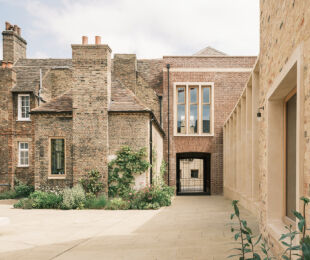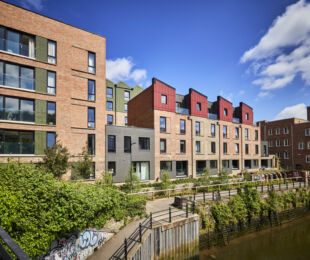
Completed in 1962, Harvey Court in Cambridge is regarded as a pivotal project in twentieth-century British architecture, pointing the way towards a relaxed, sensitive approach that embraced tradition yet sought modern solutions. Fifty years later the building was in need of updating and a sympathetic restoration was undertaken by Levitt Bernstein, whose co-founder David Levitt had worked in the office of Leslie Martin, architect of the original building.
Historian Peter Blundell Jones writes that: “In ‘The Buildings of England’, Nikolaus Pevsner called Harvey Court ‘the most sensational new building up to that date (1962) in Cambridge’. He attributed it to Leslie Martin and Colin St John Wilson without mention of job architect Patrick Hodgkinson or the Cambridge School. Yet it now seems to monumentalise that whole way of thinking, by implication involving not only those three architects but many others, including the theorists of the Martin Centre and authors of ‘Land use and built form studies’. It echoes a whole series of built and unbuilt projects – from the Oxford Law Library and Liverpool City Centre project to the Brunswick Centre in Bloomsbury and the first version of the British Library. The generous resources of an old Cambridge College made Harvey Court a special opportunity, relatively luxurious without embarrassing arguments about net to gross, so it came to idealise the foursquare stepped-section structures that characterised Martin’s empire. Displaying natural materials in contrasting textures, it also marked the peak of The New Brutalism, and the published photographs were seductive, with generous steps rising to the magic court and terraces of rooms beyond. Encountering the view of that enclosed space can still be breathtaking and the step-backs make it feel generous, but the back facing West Road has always been criticised as too hard and blank. Contextual it was not, for a green site meant freedom, modernist buildings were expected to stand in contrast with surroundings, and published photos stressed their free-standing nature.”
Matthew Goulcher of Levitt Bernstein, architect for the refurbishment, writes: “Construction on Harvey Court commenced in 1957 and was completed in 1962. The building provides student accommodation on the upper three floors of this four-storey building with ancillary accommodation at ground-floor level. The construction comprises precast and in-situ concrete floors supported by mostly loadbearing brickwork with some concrete framing elements of precast, in-situ and post-tensioned reinforced concrete.
The external elevations exemplify the sculptural use of virtually consistent brick, which is the essential characteristic of the building. The strongly expressed rhythm of vertical elements, the outward expression of the staircases and the use of special bricks for copings etc are key elements of the building in which a single brick type serves to emphasise the single-mindedness of the design. In contrast, the south external elevation and internal courtyard elevations are much more lightweight with a grid of fully glazed rooms divided by brick cross-walls stepping backwards behind shared balconies.
The refurbishment encompassed restoration works and improvements to the grade-two* listed building. The original objective was to address defects and make the building safe and watertight in a phased programme over a number of years, but the decision to close the building for an academic year allowed the college to meet long-term objectives to provide better conditions for students, improved security and access.
The accommodation was outdated, lacking en-suite facilities, and requiring improved and more secure access. Fabric improvements were needed to increase comfort and save energy, and the building had suffered persistent leaks, almost from the outset, resulting in repairs that had compromised the original design.
The external brickwork elevations had suffered from local historic cracking caused by thermal movement. When designing the building, the architects and structural engineers had tested the anticipated movement with the Building Research Station (now BRE). However, in practice there proved to be an inadequate number of movement joints. Vertical joints were originally constructed at intervals between 10 and 17 metres along the elevations with the first up to 11 metres from a corner. Current practice suggests that they should be installed at 12 metres maximum spacing and no more than six metres from a corner. Vertical movement joints had been formed in a ‘toothed’ arrangement following the line of the mortar joints to disguise their presence. The joint was filled with impregnated fibreboard and pointed in mortar. Being unable to accommodate movement, much of the mortar had fallen out, giving the misleading appearance of a crack in the brickwork.
Other minor areas of cracking in the brickwork were evident around the lower levels of the building and at vulnerable locations such as at the heads of small brick piers to the inner terrace. These were attributed to thermal and differential material movement.
We were fortunate that not all of the original pavers had been removed since the building was first built and a new build up incorporating waterproofing, insulation and a linear drainage system was finished with new brick pavers, carefully sourced to match those retained originals. We were able to reinstate the contrasting band pattern across the podium, which was evident from historic photographs.
The parapet walls were repaired by temporarily removing the brick coping and replacing the inner brick leaf, keeping the outer leaf clamped in place. The new inner leaf was constructed with a replacement brick, given that the original Williamson Cliff brick could no longer be sourced. Adjacent to the sliding doors, the existing brick piers were propped up while the lower courses were replaced to dress the waterproofing into. These significant intervention works are largely unnoticed and were trialled via a pilot project ahead of the main contract.
In addressing the brickwork repairs, it was considered that no new movement joints would be required, the building being of an age when it would have undergone its most significant movement and settling. Rather than piecing in new bricks to replace those damaged (which would been visually more damaging), cracks were repaired using an injected waterproof backing and faced with a weak mix mortar grout to match the brick colour. New bricks were only used in non-critical locations for new construction such as the inner leaf of the parapet walls and in the new entrance area.”






